Positive experiences around reading: 8 helpful tips for teachers and parents
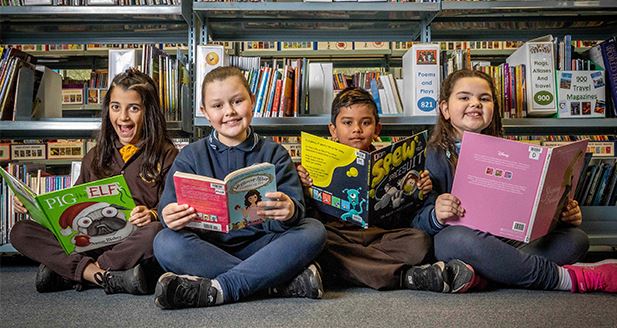
I am frequently asked, “How can I improve my child’s writing?” or “How can I improve my child’s understanding of maths?” You might be surprised to hear that I often suggest reading is the fundamental skill that can help to develop knowledge in other areas of the curriculum. Time and time again I see students who are great at practical maths but fall down in problem solving.
Cultivating a positive experience around reading is, in my opinion, one of the most crucial steps we can take to give our children the best start in education.
Some children may struggle at first to discover a love of reading, many other children drop reading and others just aren’t motivated to read. Let’s look at 8 ways to motivate children to read – we’ve aimed this at readers of all ages and abilities and for both teachers and parents.
1. Ask students to complete a timeline of their own experience with reading
You might introduce this by saying: “When I was little I loved listening to my mum read The Hobbit. Then for a short time, I stopped enjoying reading, but that was mostly because I found it difficult to find books that I liked. After a while, I discovered some interesting non-fiction books about The Bermuda Triangle and I was keen to read again. Then in high school, I was influenced by reading the classic To Kill a Mockingbird. Now as an adult I always make time to read each day, I share book titles with friends and follow my favourite authors on social media.”
You can draw this timeline for your students/children, mapping out the peaks and troughs associated with the different stages of a reading journey. We want kids to understand that their journey is important, as learning to read is not a simple, straightforward task. There will be highs and lows and at times they will struggle. Tell them that together you will find out the best ways to help them stay inspired with reading.
2. Set a meaningful goal around reading
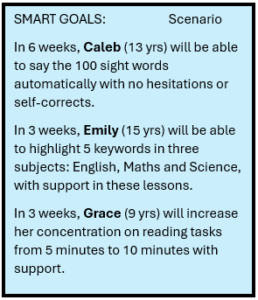 What are their future goals? Do they want to read a chapter per night? Encourage students to set Specific, Measurable, Attainable, Relevant, and Time-bound (SMART) goals. Guide them to think about their current reading abilities and identify areas where they can challenge themselves to grow. Emphasize the importance of setting goals that are realistic and aligned with their interests and aspirations. Working on SMART goals also provides greater opportunities for adults and students to work collaboratively. As the student achieves mastery of one SMART goal, they can contribute to setting the next mini-goal.
What are their future goals? Do they want to read a chapter per night? Encourage students to set Specific, Measurable, Attainable, Relevant, and Time-bound (SMART) goals. Guide them to think about their current reading abilities and identify areas where they can challenge themselves to grow. Emphasize the importance of setting goals that are realistic and aligned with their interests and aspirations. Working on SMART goals also provides greater opportunities for adults and students to work collaboratively. As the student achieves mastery of one SMART goal, they can contribute to setting the next mini-goal.
3. Why must it always be toilet-humour books?
I’ve been there with my kids and it drove me nuts: boys (& girls) who read and re-read the same type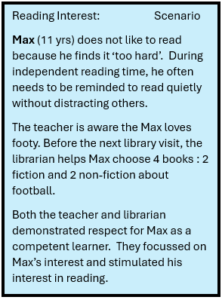 of book. My advice to teachers and parents is that you have to help kids out of this reading rut. As a parent or teacher, you will probably have 20 knockbacks of the books that you suggest but it might be book #21 that pushes them out of their comfort zone and onto new discoveries. Use your local library, borrow books from other friends/parents or send a message to the school librarian to help with suggestions. Don’t give up! Read the same books as them. Here’s my shared experience on ABC Radio of reading books about zombies (which is not my genre, but it reinvigorated my son’s interest in reading and was written by an amazing author of a great series). It’s so rewarding if you can get children onto a new author or series.
of book. My advice to teachers and parents is that you have to help kids out of this reading rut. As a parent or teacher, you will probably have 20 knockbacks of the books that you suggest but it might be book #21 that pushes them out of their comfort zone and onto new discoveries. Use your local library, borrow books from other friends/parents or send a message to the school librarian to help with suggestions. Don’t give up! Read the same books as them. Here’s my shared experience on ABC Radio of reading books about zombies (which is not my genre, but it reinvigorated my son’s interest in reading and was written by an amazing author of a great series). It’s so rewarding if you can get children onto a new author or series.
With school holidays approaching, try these book suggestions so they have reading material ~
4. “I don’t understand it!” Explicit instruction of comprehension
Students must be able to identify what they do understand and what they do not understand when reading text. Often a student will say “I don’t understand/It doesn’t make sense to me”, when in fact what the student means is that they don’t understand some parts of the text.
Teach students to become detectives and to look for clues that will lead to a better understanding or comprehension of text. Clues may include:
- headings and subheadings
- pictures, diagrams, illustrations
- keywords or phrases
Look at the content that precedes or follows for clues. What are the main ideas? Can you use your background knowledge? Can you identify the key main points/main facts?
** Many schools use our program for explicit instruction of these comprehension skills. Interactive whiteboards are brilliant for using Literacy for Kids or Literacy for Boys texts to go through key comprehension skills.
5. Use Social Media to connect with authors
The power of social media is phenomenal. I’ve used Skype to connect with authors and sometimes you might receive bookmarks and posters regularly. All questions on authorial intent could be answered by the person who actually wrote the book, which is hugely powerful. Authors love to communicate with children reading their book and it causes a really special connection for the children.
For older students, Instagram can be levered to follow authors, or other keen readers.
6. Attitudes to reading
Students who are struggling readers will usually say they ‘hate reading’. In essence, what they hate is being different from other students, feeling nervous, anxious or embarassed when asked to read, being labelled, not being able to complete their school work, finding ways to disguise their poor reading skills and struggling to perform academically. As students mature, this can become self-defeating: “I can’t read, so why bother?”
Use our visual questionnaire to engage students in examining their feelings about reading ~ this may be impacting their reading progress. LFK Reading Interest Survey Worksheet
7. Reading Aloud
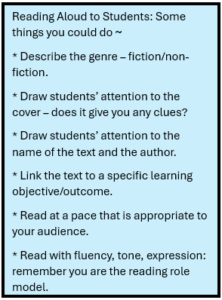 When teachers or parents read aloud, they are modeling fluency by demonstrating skills such as rhythm, phrasing, intonation, naturalness and use of voice for different characters/moods. When an adult reads aloud, they can stop and explore new words, investigate meaning and helps students to make connections with what they already know, think or understand.
When teachers or parents read aloud, they are modeling fluency by demonstrating skills such as rhythm, phrasing, intonation, naturalness and use of voice for different characters/moods. When an adult reads aloud, they can stop and explore new words, investigate meaning and helps students to make connections with what they already know, think or understand.
8. Independent Reading
The ultimate goal is to promote the habit of regular independent reading for pleasure. When we get our students to this point, they will select their own books and read about topics or subjects in which they are interested and that they enjoy. Where students independently choose books that are above their reading skills level, they can be supported to develop strategies – such as conferencing with other students – to overcome reading challenges.
Summary
Learning to read is a complex social and cognitive task that requires explicit, direct and sequenced instruction, daily practice and timely support. To be effective in supporting reading development, it is important to understand how reading develops and the strategies that can be used to support reading development. Reading programs can greatly assist teachers and parents but it is also important to build a repertoire of reading games, activities and modeling to create positive experiences around reading.
Want your students to finish strong in their literacy? Want more from your literacy program? Contact us for a 30-day free trial in your school or classroom. New schools receive this terrific Teaching Resource: 51 Writing Prompts. These are a complete hit with our schools and you will not be disappointed with these image-rich, kid-centred Writing Prompts that will enthuse your writers.
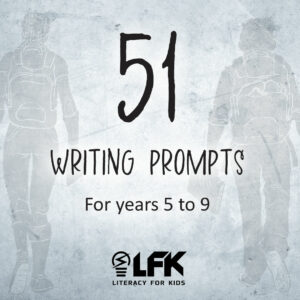



Check out our blogs for more ideas and tips.
Outstanding Results from School Using LFK and LFB
Resources for Reluctant Writers: in the classroom and at home
Track Each Boy’s Progress and Improve their Outcomes – Literacy for Boys Student Dashboard
7 Parent friendly tips for comprehension
Get boys reading in the digital age
What to do when your son hates reading – 6 top tips
Brought to you by Tanya Grambower
